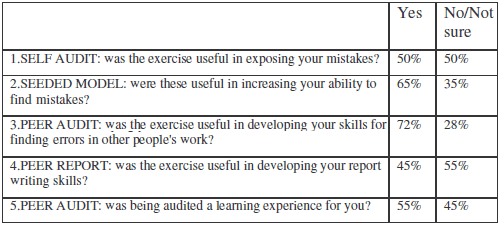Authors
David Chadwick & Rodney E. Sue
Abstract
Recent research has highlighted the high incidence of errors in spreadsheet models used in industry. In an attempt to reduce the incidence of such errors, a teaching approach has been devised which aids students to reduce their likelihood of making common errors during development.
The approach comprises of spreadsheet checking methods based on the commonly accepted educational paradigms of peer assessment and self-assessment. However, these paradigms are here based upon practical techniques commonly used by the internal audit function such as peer audit and control and risk self-assessment.
The result of this symbiosis between educational assessment and professional audit is a method that educates students in a set of structured, transferable skills for spreadsheet error-checking which are useful for increasing error-awareness in the classroom and for reducing business risk in the workplace.
Sample

Anonymous feedback was obtained from 42 participating students who answered five questions and were permitted to give comments.
All reported favourably on most criteria (except report writing) saying they had not only learned from the experience but also enjoyed it.
Publication
2001, EuSpRIG
Full article
Teaching spreadsheet development using peer audit and self-audit methods for reducing errors
